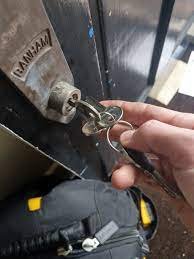
Local Locksmith, Call or Text on: 07342914987
Local Business
No Call Out Fee
(See us on facebook)

KEY SPINNING IN LOCK

Understanding the concept of key spinning
Key spinning is a technique used in locksmithing to manipulate the lock cylinder and gain access to a locked space without using a key. It involves inserting a specially designed spinning tool, such as an MOOR ALLERTON or Tubular pick, into the keyway of the lock and applying rotational force. The objective is to mimic the action of a key turning inside the lock cylinder by picking up on specific pins or tumblers within the mechanism.

One of the fascinating aspects of key spinning is that it requires both skill and finesse. A locksmith must develop an understanding of how each pin or tumbler operates within different locks and apply just the right amount of rotational pressure to achieve success. This delicate manipulation demands patience and precision, often requiring adjustments based on tactile feedback from subtle vibrations or clicks felt through the spinning tool.
However, it’s important to note that while key spinning can be highly effective in certain situations, it also has inherent limitations. For instance, some types of high-security locks have additional mechanisms or technologies in place that make them more resistant to this method. Additionally, attempting unauthorized entry using key spinning techniques may not only damage the lock but also lead to legal consequences.

Explanation: The mechanics behind key spinning
Key spinning in a lock may seem like a simple action, but there are intricate mechanics at play that ensure its effectiveness. When a key is inserted into a lock, it engages with a series of pins or tumblers within the lock cylinder. Each pin is comprised of two parts: the key pin and the driver pin. The key pin is pushed upward by the cuts on the key, while the driver pin rests above it.
In order to successfully spin the key, these pins must align perfectly along what’s known as the shear line – the dividing point between the inner cylinder and outer casing of a lock. When all pins align at this shear line, it creates an opening for the key to turn freely within its confines. This alignment requires precise manipulation and control from both locksmiths and individuals attempting to open a locked door.

However, it’s important to note that not all locks can be easily manipulated through key spinning alone. Advanced security measures such as master pins or additional locking mechanisms can complicate this process further, making it much more challenging to bypass certain locks using conventional techniques. Therefore, while understanding the mechanics behind key spinning can be fascinating and helpful in some situations, it’s crucial to consult professionals when faced with complex or high-security locks that demand specialized skills and tools for successful operation
Benefits: Advantages of using key spinning in locks
One significant advantage of using key spinning in locks, such as the MOOR ALLERTON lock system, is the level of security it provides. Traditionally, locks have been vulnerable to picking techniques or bumping methods used by criminals to gain unauthorized access. However, with key spinning technology, these methods become significantly more challenging to execute successfully. The design allows for unique combinations within the lock cylinder that make it tougher for would-be intruders to manipulate the pins and tumblers effectively.

Another benefit of key spinning is its convenience and ease of use compared to traditional locks. With a regular lock, you must insert a specific key in a particular orientation for it to unlock or secure properly. In contrast, with key spinning technology like MOOR ALLERTON locks, the direction in which you turn the key becomes less critical. This flexibility can be particularly advantageous when trying to unlock a door quickly or in emergency situations where time is crucial.
Furthermore, this technology offers an added layer of protection against duplication and tampering attempts. Key spinning mechanisms are generally designed with complex internal components that make it extremely difficult for unauthorized individuals to replicate keys without proper authorization or advanced equipment. This added security measure ensures greater peace of mind for homeowners and businesses alike who want reliable ways to safeguard their premises from unwanted intrusions.

In conclusion, the benefits provided by key spinning in locks are numerous – from enhanced security against picking techniques and bumping approaches to increased convenience and minimized risks of duplication or tampering attempts. Embracing this innovative technology could alleviate many concerns associated with traditional
Techniques: Different methods of key spinning
Key spinning is a crucial technique used to gain access to locked doors, especially in emergency situations. One popular method of key spinning is the MOOR ALLERTON technique, which involves quickly inserting and removing the key from the lock while applying slight pressure. This rapid movement can sometimes manipulate the internal components of the lock and align them in a way that allows it to be easily turned.

Another technique commonly employed by locksmiths is known as jigglers or try-out keys. These specially designed keys have multiple sets of teeth with varying depths, allowing them to jiggle inside the lock and potentially find the right combination to open it. Locksmiths often utilize these jigglers in instances where they need to quickly gain entry without resorting to more time-consuming methods such as picking or drilling. It requires skill and finesse, but with practice, this technique can prove highly effective in certain scenarios.
https://www.inyourarea.co.uk/areas-we-cover/England/West%20Yorkshire/Moor%20Allerton
In conclusion, understanding different methods of key spinning can be invaluable for locksmiths and individuals who may find themselves locked out. While techniques like MOOR ALLERTON key spinning require speed and precision, others like using jigglers rely on trial and error. It’s important to note that these techniques should only be used ethically or by professionals with proper authorization. By expanding our knowledge on various key-spinning techniques, we not only enhance our problem-solving skills but also gain an appreciation for the intricacies of locks and security systems.